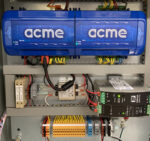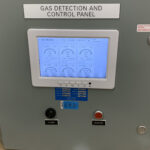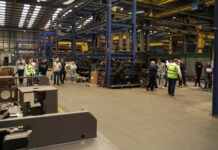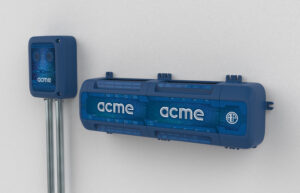 Whether new or retrofit construction, monitoring hazardous gases in industrial plants and warehouses, as well as at loading docks and receiving areas, is often crucial to safety, compliance, and productivity. Exposure to potentially toxic gases can come from a wide variety of sources, particularly in partially or totally enclosed areas.
Whether new or retrofit construction, monitoring hazardous gases in industrial plants and warehouses, as well as at loading docks and receiving areas, is often crucial to safety, compliance, and productivity. Exposure to potentially toxic gases can come from a wide variety of sources, particularly in partially or totally enclosed areas.
According to an OSHA Factsheet, carbon monoxide (CO) is a common industrial hazard resulting from the incomplete burning of material containing carbon such as natural gas, gasoline, oil, propane, or coal.
“Carbon monoxide is harmful when breathed because it displaces oxygen in the blood and deprives the heart, brain and other vital organs of oxygen. Large amounts of CO can overcome you in minutes without warning — causing you to lose consciousness and suffocate,” states the OSHA Factsheet.
“You may be exposed to harmful levels of CO in boiler rooms, warehouses, petroleum refineries, pulp and paper production, and steel production; around docks, blast furnaces, or coke ovens” as well as in occupations such as forklift operator, diesel engine operator, and welder, adds the Factsheet.
Similarly, industrial workers are exposed to nitrogen dioxide (NO2) from the burning of fuel for vehicles, equipment, and power generation, which can cause respiratory irritation and aggravate respiratory diseases.
Within warehouses and around loading docks/receiving areas, propane burning forklifts and equipment can result in a build-up of carbon dioxide (CO2) with complete combustion, or result in excess CO with incomplete combustion. Breathing too much CO2 can cause headaches, dizziness, difficulty breathing, elevated blood pressure, and even coma, asphyxia, and convulsions.
Even with ventilation systems installed, the systems can be insufficient, become overwhelmed, or break down and fail. Any areas at risk in industrial plants and warehouses should be continually assessed to avoid the inadvertent accumulation of dangerous gases.
To enhance safety, comply with regulations and minimize the risk of dangerous gases that can be inhaled or even flammable or explosive, gas monitoring systems can be set to detect for specific thresholds. After detection, such systems will typically alarm to warn workers in the vicinity, and can also text or email supervisory personnel or managers to trigger an immediate response. A record is often kept to document compliance.
However, the challenge is that industrial processes and capacities change over time. Design specifications written at the start of a project can evolve, and so can the requirements. Also, local jurisdictions and code officials may have different demands that must be accommodated.
“On almost every project, design changes occur so we choose to work with expert vendors that help us quickly adapt,” says Adam Hitchen, President of Atlantis Comfort Systems, a Rhode Island-based HVAC contractor that provides commercial and residential service across the East Coast.
According to Hitchen, in one project in Boston there were changes in the design of a loading dock area that required accommodation.
“They erected a wall, which required an extra ventilation system, a makeup air system, an independent CO/CO2 detection system, and a change in the existing panel planned for the job,” says Hitchen.
“Our vendor helped us change midstream seamlessly. Acme provided the new system, the new panel, and adjusted the existing panel,” says Hitchen, who notes that the wiring diagram, engineering drawing, and necessary sequence of operations was also provided.
Acme Engineering is an ISO 9001:2015 certified manufacturer of environmental controls and systems with integrated mechanical, electrical and electronic capabilities. The company has expertise providing equipment for monitoring a variety of gases such as carbon monoxide, nitrogen dioxide, carbon dioxide, hydrogen, ammonia, and refrigerants.
Next Generation Wireless
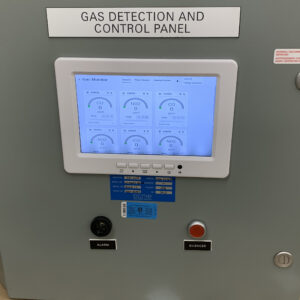 Wireless capability is extremely advantageous from an installation point of view for reducing installation time and costs. Gas detection networks, generally speaking, are installed by licensed electricians and labor costs are fairly high. With wireless gas detection networks, all that is required is mounting the sensors and establishing the connection with the system.
Wireless capability is extremely advantageous from an installation point of view for reducing installation time and costs. Gas detection networks, generally speaking, are installed by licensed electricians and labor costs are fairly high. With wireless gas detection networks, all that is required is mounting the sensors and establishing the connection with the system.
“In terms of installation, a warehouse can have 40-foot-high ceilings so it would be costly to run conduit and wires all over for gas monitoring, power and connectivity. Loading docks tend to be situated at the ends of a facility, so wireless could be a big benefit there too. By avoiding the cost and complexity of requiring an electrician for such areas, you could probably save about 20 percent on installation costs,” says Rainone.
Acme, for its part, has developed a wireless version of its MGMS system that incorporates a unique Wi-Fi capability, so it is not necessary to have a control panel as the sole point to receive feedback from the gas detection network. With the wireless MGMS users can observe current conditions via their computers, tablets, and phones, with real-time alarms in case of emergency.
“When it comes to reducing installation cost and expediting the project, there is going to be a benefit with wireless. Because anytime you eliminate conduit and wire from one sensor to the next, to the next – and you eliminate all that material and labor – there are going to be savings with wireless,” concludes Rainone.



































